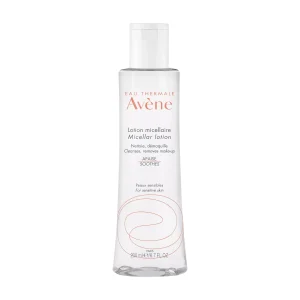
Do you suffer from shine and dry patches? Do you want to remove excess oil without stripping it away too much? If you have combination skin, you know these factors all too well. You may be looking for the best cleanser for combination skin to reduce breakouts and keep excess oil at bay without damaging the moisture barrier. In this article from The Dermo Lab and in collaboration with the dermatologist Dr. Mohamed Tayeh, we’ll dive into cleansers that aim to restore harmony and reintroduce balance.
What is combination skin?
According to Dr. Mohamed Tayeh, a combination skin type is characterized by dry, flaky skin on the cheeks, while excess oil and shine appear on other areas of the face.
A variety of factors can contribute to the development of combination skin, but it’s often a matter of luck, depending on what you inherited from your parents. Seasonal weather changes can also play a role and the types of skin care products you use can absolutely exacerbate combination skin.
An overproduction of skin oil (called sebum) leads to an oily t-zone. If not regularly cleansed and exfoliated, this sebum can stay in the pores, mix with dead skin cells and promote breakouts.
What are the signs of combination skin?
Because combination skin and oily skin look alike, people often confuse these skin types. Here are five symptoms associated with combination skin.
- You have both oily and dry skin patches
To find out if you have combination skin, wash your face, leave it bare and wait an hour. Does your skin look oily in the T-zone, but normal or dry on your cheeks and jawline? If so, you probably have combination skin. This skin type is exactly what it sounds like – a combination of several skin types – and as a result, you’ll have both oily and dry patches on your complexion.
- You have mild breakouts and dryness at the same time
Clogged pores are often synonymous with breakouts. Due to excessive oil production, combination skin often experiences occasional mild acne breakouts, especially during hormonal fluctuations like menstruation. These blemishes tend to be concentrated in the T-zone, where the sebaceous glands are most active, while the areas around the cheeks, jawline, and hairline remain dry.
- The pores on your nose, chin, and forehead are larger
Do you notice large pores on your nose, chin, and forehead? Combination skin is characterized by overactive sebaceous glands in the T-zone. As a result, the nose, chin, and forehead of combination skin are more prone to clogged pores. When oil builds up inside the pores, they have to expand to contain the excess oil, which makes them look larger.
- Your makeup looks patchy
Is your makeup sliding down your T-zone and clinging to your cheeks? Chances are, you have combination skin.
- Your skin is more oily in the summer and drier in the winter
In the summer, heat, and humidity increase sebum production, making the T-zone look very oily and dry areas look more “normal”.
In winter, the opposite happens: Exposure to the environment sucks the moisture out of your skin and your T-zone will look “normal” while your dry areas will look drier.
How to choose the best cleanser for combination skin?
When looking for the right cleanser for your combination skin type, we recommend choosing a product that is both soothing and clarifying.
Those of you with combination skin need to regulate oil and sebum production along the T-zone. Make sure the products you have are labeled “non-comedogenic,” which means they won’t clog your pores. Avoid products that are too emollient, i.e. creamy or greasy, as they may clog pores.
At the same time, you don’t want to use products that can increase oil production or further dry out your dry areas. It’s helpful to avoid alcohol and fragrances, which can dry out your skin and further activate oil production. Dr. Mohamed Tayeh explains that alcohol can irritate dry and oily skin. Dry areas can become drier, while oily areas can produce more sebum, which can lead to breakouts.
The best cleansers for combination skin are those that remove buildup and dirt without disturbing your skin’s natural oil balance. Try a combination cleanser or a gentle cleanser formulated for all skin types, like Eau Thermale Avène Micellar Lotion. We recommend the following product as it is one of the best face cleansers for sensitive combination skin. Its composition containing Avène Thermal Spring Water brings softness and freshness in a simple and fast gesture.
Eau Thermale Avène Micellar Lotion
What other tips are there for treating combination skin?
Dr. Mohamed Tayeh notes that it is also important to find an oil-free moisturizer, exfoliate at least once a week, and use antioxidants.
1- Find a moisturizing, oil-free moisturizer
An oil-free moisturizer will give your dry areas the moisture they need while regulating oil production in the T-zone.
2- Exfoliate at least once a week
Dead skin cells mixed with sebum in the skin’s pores are a breeding ground for blemishes. Regularly removing dead skin cells from the skin’s surface will help keep your skin from becoming clogged.
3- Use antioxidants
Retinol (a form of vitamin A) is a great antioxidant for fighting oily T-zones. Look for it in a serum to use before applying a lightweight, non-comedogenic moisturizer.
Takeaway
People with combination skin have both dry and oily areas of skin. To care for combination skin, it is often necessary to use different products on the dry and oily parts of the face. Sticking to ingredients that moisturize but don’t make your face oily can help you maintain a balance.
If you want to keep things simple in your skin care routine, opt for a gentle cleanser, a moisturizer with hyaluronic acid, and don’t forget to exfoliate your skin once a week.
Last Updated on February 16, 2024










